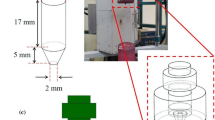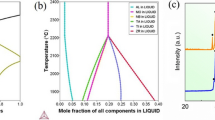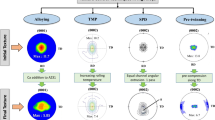Abstract
Metal-metal type amorphous wires with a good ductility were produced in the M-Zr (M=Cu, Cu-Nb and Cu-Ta) alloy systems by a technique using melt spinning into rotating water. The formation of the amorphous wires is limited to a narrow range of 35 to 40 at % zirconium where the critical sample thickness for the formation of an amorphous phase is above about 100μm and the amount of copper replaced by niobium or tantalum is less than about 7 and 5 at %, respectively. The wires have a circular crosssection and a rather smooth peripheral surface. Their diameters are in the range of 0.07 to 0.15 mm. The Vickers hardness,H v, and tensile strength,σ f, are of the order of 425 to 440 DPN and 1670 to 1810 MPa. The elongation to fracture,ε f, is about 2.4 to 2.7%. Cold drawing to about 30% reduction in area results in increases inσ f andε f by about 10% and 35%, respectively. Furthermore, the addition of 5 at % niobium results in decreases inσ f andH v by about 14% and 4%, respectively, without detriment to the good bending ductility. Owing to the faster quench rates of the wire samples, caused by the inherent differences in the solidification process of the ejected melt as well as in the manner of cooling after solidification, the amorphous wires have been found to exhibit a considerably higher relaxation enthalpy value, ΔH, and a lower temperature for the onset of structural relaxation as compared with the amorphous ribbon having the same thickness as the diameter of the wire, demonstrating that the amorphous wires possess a higher degree of structural disorder.
Similar content being viewed by others
References
M. Hagiwara, A. Inoue andT. Masumoto,Met. Trans. 13 (1982) 373.
A. Inoue, M. Hagiwara andT. Masumoto,J. Mater. Sci. 17 (1982) 580.
M. Hagiara, A. Inoue andT. Masumoto,Mater. Sci. Eng. 54 (1982) 197.
A. Inoue, Y. Masumoto, N. Yano andT. Masumoto,J. Mater. Sci. in press.
T. Masumoto, I. Ohnaka, A. Inoue andM. Hagiwara,Scripta Metall. 15 (1981) 293.
A. Inoue, H. S. Chen, J. T. Krause, T. Masumoto andM. Hagiwara,J. Mater. Sci. 18 (1983) 2743.
I. Ohnaka, T. Fukusako andT. Daido,J. Japan Inst. Metals 45 (1981) 751.
T. Masumoto, A. Inoue, M. Hagiwara, I. Ohnaka andT. Fukusako, Proceedings of the 4th International Conference on Rapidly Quenched Metals, Sendai, August 1981, Vol. 1, edited by T. Masumoto and K. Suzuki (The Japan Institute of Metals, Sendai, 1982) p. 47.
H. S. Chen, R. C. Sherwood, S. Jin, G. C. Chi, A. Inoue, T. Masumoto andM. Hagiwara,J. Appl. Phys. 55 (1984) 1796.
A. Inoue andT. Masumoto,Engng Mater. 30 (5) (1982) 47, in Japanese.
M. Hagiwara, A. Inoue andT. Masumoto,Met. Trans. 12A (1981) 1027.
Idem, Sci. Rep. Res. Inst. Tohoku Univ. A-29 (1981) 351.
M. H. Cohen andD. Turnbull,Nature 189 (1961) 131.
D. Turnbull,Contemp. Phys. 10 (1969) 473.
H. A. Davies, “Rapidly Quenched Metals III”, edited by B. Cantor, Vol. 1 (The Metals Society, London, 1978) p. 1.
M. Naka, Y. Nishi andT. Masumoto,ibid.“ p. 231.
Y. Nishi, K. Suzuki andT. Masumoto, Proceedings of the 4th International Conference on Rapidly Quenched Metals, Sendai, August 1981, Vol. 1; edited by T. Masumoto and K. Suzuki (The Japan Institute of Metals, Sendai, 1982) p. 217.
H. S. Chen,Acta Metall. 22 (1974) 897.
D. Turnbull,J. Phys. Colloque-4 35 (1974) 1.
“Metals Databook” (The Japan Institute of Metals, Maruzen, Tokyo, 1974) p. 156.
S. Tomizawa andT. Masumoto,Sci. Rep. Res. Inst. Tohoku Univ. A-26 (1977) 263.
A. Inoue, T. Masumoto, M. Hagiwara andH. S. Chen,Scripta Metall. 17 (1983) 1205.
Idem, unpublished research (1982).
A. Inoue, H. S. Chen andT. Masumoto,J. Non.-Cryst. Solids 61/62 (1984) 949.
Y. Ishihara, private communication, Hitachi Research Laboratory, Hitachi Ltd, Hitachi 317, Japan, August 1981.
Author information
Authors and Affiliations
Rights and permissions
About this article
Cite this article
Inoue, A., Masumoto, T. & Yano, N. Production of metal-zirconium type amorphous wires and their mechanical strength and structural relaxation. J Mater Sci 19, 3786–3795 (1984). https://doi.org/10.1007/BF00552292
Received:
Accepted:
Issue Date:
DOI: https://doi.org/10.1007/BF00552292




